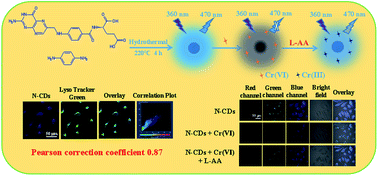Lysosome targeting, Cr(vi) and l-AA sensing, and cell imaging based on N-doped blue-fluorescence carbon dots†
Abstract
N-doped blue-fluorescence carbon dots (N-CDs) were fabricated via a one-pot hydrothermal method using folic acid and p-phenylenediamine. The obtained N-CDs exhibited strong fluorescence (FL) with a considerable quantum yield (QY) of 21.8% and exceptional optical stability under different conditions. Upon introducing Cr(VI), blue FL of N-CDs was distinctly quenched. On subsequent addition of L-AA, the FL of N-CDs could be partially recovered. The fluorescence changes of N-CDs have been utilized to detect Cr(VI) and L-AA in aqueous solutions with linear ranges of 0.10–150 μM and 0.75–2.25 mM, respectively, as well as limit of detection values of 9.4 nM and 25 μM, respectively. Furthermore, as-obtained N-CDs can be extended to monitor the fluctuation of intracellular Cr(VI) and L-AA. More intriguingly, N-CDs can target lysosomes with a satisfactory Pearson correction coefficient of 0.87, which indicates a promising application prospect in the biomedical field.

- This article is part of the themed collection: Analytical Methods HOT Articles 2021


 Please wait while we load your content...
Please wait while we load your content...